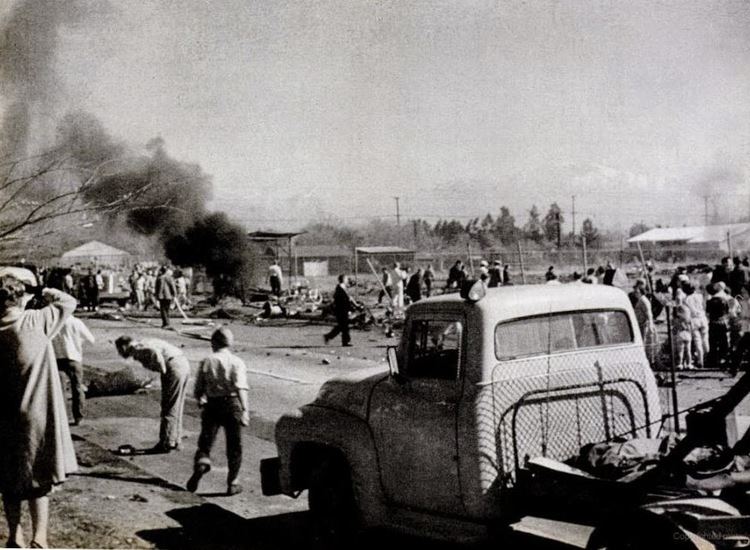Total injuries (non-fatal) 78 (estimated) Registration N8210H Passenger count 0 | Type Douglas DC-7B Date 31 January 1957 Total fatalities 8 | |
 | ||
Similar 1957 Blackbushe Viking ac, British European Airways F, Maritime Central Airways F, Sutton Wick air crash, Northeast Airlines Flight 823 | ||
On January 31, 1957, a Douglas DC-7B operated by Douglas Aircraft Company was involved in a mid-air collision with a United States Air Force Northrop F-89 Scorpion and crashed into the schoolyard of Pacoima Junior High School located in Pacoima, a suburb in the San Fernando Valley of Los Angeles, California. By February 1, seven people had died and at least 75 had been injured due to the incident. A 12-year-old boy subsequently died from multiple injuries from the incident on February 2.
Contents
The accident
The DC-7B, earmarked for delivery to Continental Airlines, took off from the Santa Monica Airport at 10:15 a.m. on its first functional test flight, with a crew of four Douglas personnel aboard. Meanwhile, in Palmdale to the north, a pair of two-man F-89J fighter jets took off at 10:50 a.m. on test flights, one that involved a check of their on-board radar equipment. Both jets and the DC-7B were performing their individual tests at an altitude of 25,000 feet in clear skies over the San Fernando Valley when, at about 11:18 a.m., a high-speed, near-head-on midair collision occurred. Investigators were later able to establish that the two aircraft most likely converged at a point in the sky approximately one to two miles northeast of the Hansen Dam spillway.
Following the collision, Curtiss Adams, the radarman aboard the eastbound twin-engine F-89J Scorpion, was able to bail out of the stricken fighter jet and, despite incurring serious burns, parachuted to a landing onto a garage roof in Burbank, breaking his leg when he fell to the ground. The fighter jet's pilot, Roland E. Owen, died when the aircraft plummeted in flames into La Tuna Canyon in the Verdugo Mountains.
The DC-7B, with a portion of its left wing sheared off, remained airborne for a few minutes then rolled to the left and began an uncontrollable, spiraling, high-velocity dive earthward. In doing so, it began raining debris onto the Pacoima neighborhoods below as the aircraft began to break apart. Seconds later, part of the hurtling wreckage slammed onto the grounds of the Pacoima Congregational Church, killing all four Douglas crewmen aboard while the major portions fell onto the adjacent playground of Pacoima Junior High School. On the school playground, where some 220 boys were just ending their outdoor athletic activities, the wreckage broke upon impact into numerous pieces and intense fires began due to the aircraft's fuel and oil. Distinct craters were made in the playground by each of the four engines and the main center fuselage section. Two students, Ronnie Brann, 13, and Robert Zallan, 12, were struck and killed by this wreckage and debris. A third gravely injured student, Evan Elsner, 12, died two days later in a local hospital. An estimated 75 more students on the school playground suffered injuries ranging from critical to minor.
The collision was blamed on pilot error and the failure of both aircraft crews to exercise proper “see and avoid” procedures regarding other aircraft while operating under visual flight rules (VFR). The crash also prompted the Civil Aeronautics Board (CAB) to set restrictions on all aircraft test flights, both military and civilian, requiring that they be made over open water or specifically approved sparsely populated areas.
Popular culture
The crash is referenced in the 1987 film La Bamba, a biographical account of the life of rock and roll singer Ritchie Valens. A 15-year-old student at Pacoima Junior High School at the time of the disaster, Valens was not at school that day because he was attending the funeral of his grandfather. Due to the disaster, Valens developed a fear of flying that he overcame after he launched his music career. Valens, along with fellow musicians Buddy Holly and The Big Bopper, and pilot Roger Peterson, perished two years later in an airplane crash when their chartered Beechcraft Bonanza crashed near Mason City, Iowa, in the early morning hours of February 3, 1959.
The crash was discussed on the May 19, 1957, episode of The CBS Radio Workshop (entitled "Heaven Is In the Sky"). The program described when and how both planes took off from their various airstrips, and included discussion of how the Pacoima Junior High School was having the 7th grade students outside for exercise. It also included interviews with people who were witnesses and/or affected by the crash, such as Ronnie Brann's mother and a close friend.
